The Vishera Review: AMD FX-8350, FX-8320, FX-6300 and FX-4300 Tested
by Anand Lal Shimpi on October 23, 2012 12:00 AM ESTProjected Performance: Can AMD Catch up with Intel?
I keep going back to this slide because it's incredibly relevant. It's the only indication we have from AMD of what its future roadmap will look like in terms of performance increases:
Each year AMD promised to increase performance of its high-end cores by roughly 10 - 15%. Astute observers will note that, at this rate, AMD will almost never catch up to Intel. AMD at the time was careful to point out that it's talking about 10 - 15% gains in core performance, and it could potentially see even larger increases in total chip performance by pulling other levers. Vishera is an example of AMD doing just that. The Piledriver cores by themselves don't increase performance tremendously, but they do give AMD a little more thermal headroom to work with thanks to some more efficient design decisions and better transistor choice. With Vishera, AMD took the additional power headroom and turned into a frequency advantage. The result is AMD's FX-8350 can operate in the same power envelope as the outgoing FX-8150, yet runs at an 11% higher base clock (turbo frequency remains the same). Through frequency and core level improvements, AMD was able to deliver a bit more than the 10 - 15% performance increased in promised.
If AMD is able to repeat these improvements again next year, I wondered whether or not it would get any closer to closing the gap with Intel - particularly when it came to single threaded performance. We already know from our Haswell investigations that Intel is expecting around a 5 - 15% increase in CPU performance from Haswell over Ivy Bridge. If we assume that Haswell delivers towards the 15% end of that spectrum, and if we assume that Steamroller delivers the same level of improvements that we saw from Piledriver/Vishera, we end up with some pretty interesting predictions for where things end up next year. I modeled the 2013 performance of high-end AMD and Intel platforms based on those two factors and plotted the curves in a few different benchmarks. For each generation I used the parts that AMD stacked up against one another (they are also fairly similarly priced). For 2011 I used the FX-8150 vs. Intel's Core i5 2500 and for 2012 I used the FX-8350 vs. Intel's Core i5 3570. The 2013 data is of course projected based on a 15% increase in performance from Haswell, and a repeat of the Vishera vs. Zambezi increase for AMD. This is mostly an interesting experiment so don't get too invested in the data.
We'll start with Cinebench, by far the most painful of the tests for AMD from a single-threaded performance perspective:
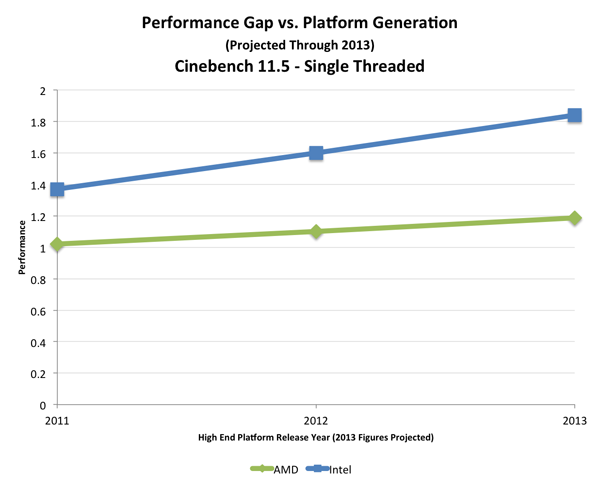
The Vishera gains here were decent but not enough to dramatically shrink the performance gap. Furthermore, Intel put a good amount of distance in place with Ivy Bridge and if it can continue that with Haswell I don't see much hope here.
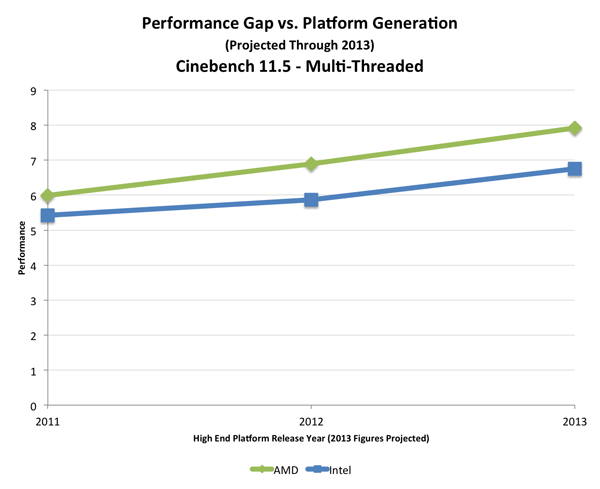
The multithreaded Cinebench results begin in AMD's favor and remain so even with our projected performance data.
Mozilla's Kraken benchmark is another example of single threaded performance gone awry for AMD.
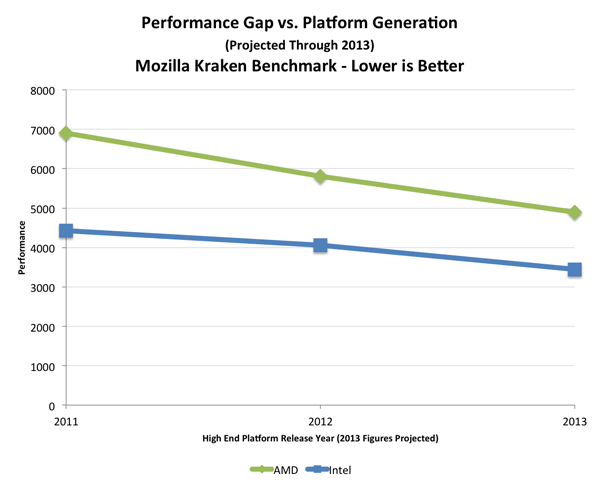
Thankfully, Vishera does close the gap by a decent amount and if AMD extends those gains it is on an intercept course with Intel. The bad news is, that intercept wouldn't be in 2013.
POV-Ray provides another point of view on single threaded performance, here the situation looks far less dire than under Cinebench:
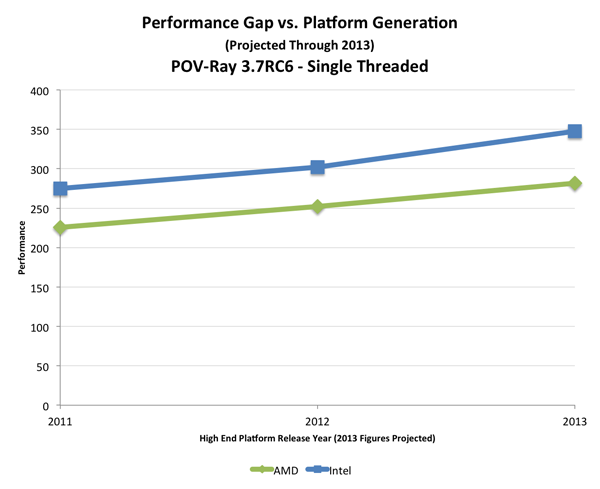
Unfortunately the curves remain fairly distinct.
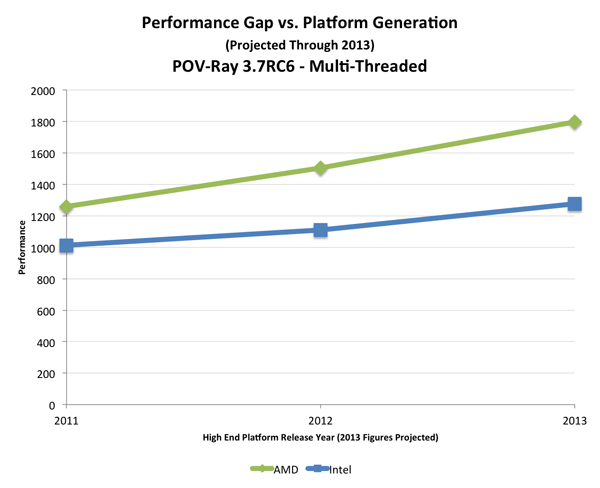
Once again, when we increase thread count we see AMD pull ahead.
SYSMark is a particularly telling benchmark as it is lightly threaded and does a good job of simulating all types of workloads:
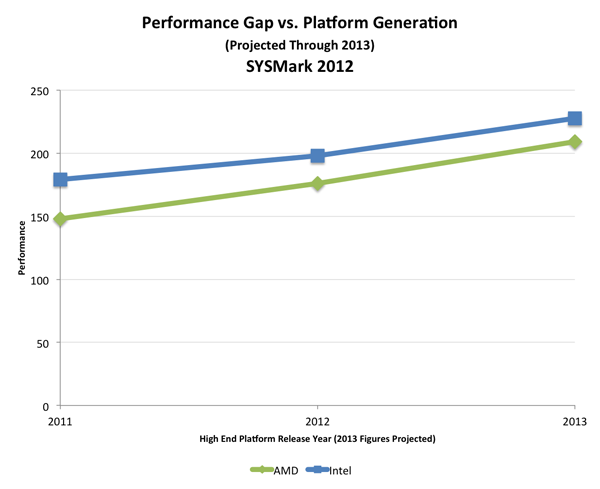
The result here is AMD closing in, albeit slowly, on Intel's performance advantage. I suspect this is quite possibly the best case scenario for AMD, it doesn't necessarily want to surpass Intel in performance but it wants to get close enough where pricing and other factors (e.g. GPU performance in its APU parts) can make a bigger difference.
Our Visual Studio 2012 test is a good combination of single threaded and multithreaded workloads in one:
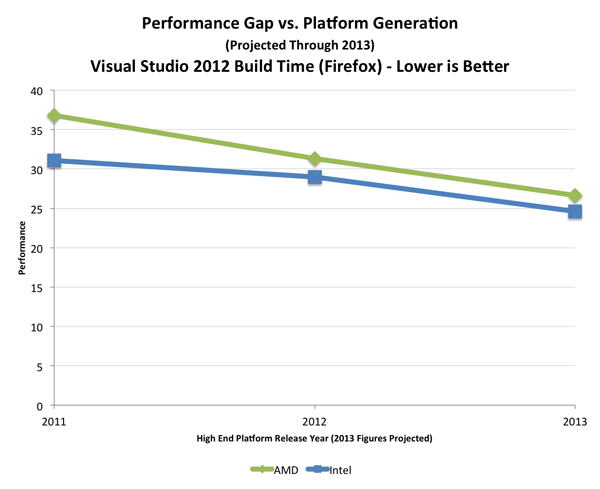
With Vishera, AMD did a lot to close the gap betwen itself and Intel. Another increase like this and we won't see AMD surpass Intel, but the two should remain fairly close.
These last two tests show us the other side of the coin. If both AMD and Intel continue on their present tracks, what will happen in a test where AMD already does well today?
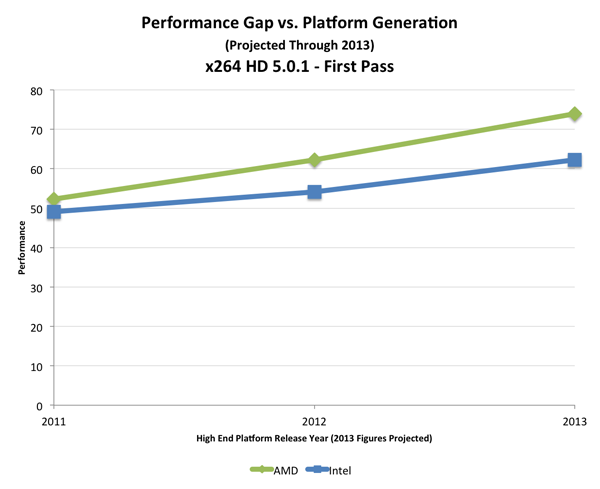
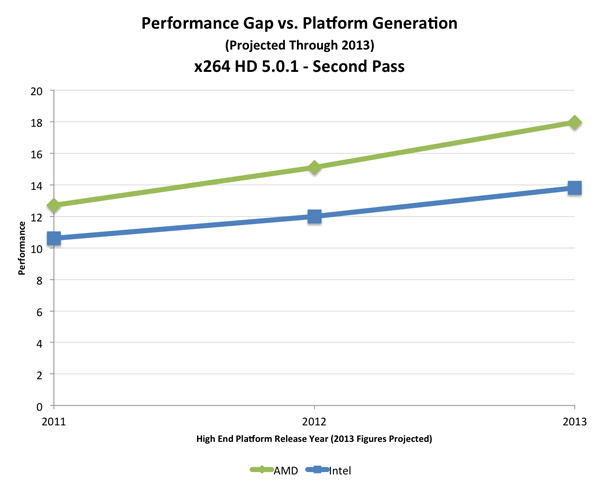
In areas where AMD holds a significant advantage, Haswell would need to deliver more than a 15% gain in performance at the same price point to catch up.
None of the results here are all that surprising. AMD remaining on its current course isn't enough to dramatically change its standings vs. Intel in another year. Vishera definitely cut into the performance delta, but the 2013 follow-up will have to do even more to really have an impact. Steamroller is far more focused on increasing IPC, however without a new process node it'll be difficult to demonstrate another gain in frequency like we see today with Vishera. I suspect the real chance for AMD to approach parity in many of these workloads will be with its 20nm architecture, perhaps based on Excavator in 2014.











250 Comments
View All Comments
apache1649 - Friday, November 29, 2013 - link
Also X is not the only option. There are other, more functional, less bulky alternativesTaft12 - Tuesday, October 23, 2012 - link
Ad hominem fallacy. Address his arguments, not the slang.Windows is inappropriate for many important purposes, it says so right there in the EULA.
jabber - Tuesday, October 23, 2012 - link
Indeed, reading a lot of comments over the past 18 months you would think AMD were still pushing their old K6-2 CPUS from the turn of the century.Build a AMD machine or an Intel one and average Joe Customer isn't going to notice.
If honest, most of us here wouldn't either probably.
CeriseCogburn - Tuesday, October 30, 2012 - link
Funny how the same type of thing could be said in the video card wars, but all those amd fanboys won't say it there !Isn't that strange, how the rules change, all for poor little crappy amd the loser, in any and every direction possible, even in opposite directions, so long as it fits the current crap hand up amd needs to "get there" since it's never "beenthere". LOL
whatthehey - Tuesday, October 23, 2012 - link
We've heard all of this before, and while much of what you say is true, and ignoring the idiotic "Windoze" comments not to mention the tirade on "evil Intel", Anand sums it up quite clearly:Vishera performance isn't terrible but it's not great either. It can beat Intel in a few specific workloads (which very few people will ever run consistently), but in common workloads (lightly threaded) it falls behind by a large margin. All of this would be fine, were it not for the fact that Vishera basically sucks down a lot of power in comparison to Ivy Bridge and Sandy Bridge. Yes, that's right: even at 32nm with Sandy Bridge, Intel beats Vishera hands down.
If we assume Anand's AMD platform is a bit heavy on power use by 15W (which seems kind as it's probably more like 5-10W extra at most), then we have idle power slightly in Intel's favor but load power favors Intel by 80W. 80W in this case is 80% more power than the Intel platform, which means AMD is basically using a lot more energy just to keep up (and the Sandy Bridge i5-2500K uses about 70W less).
So go ahead and "save" all that money with your performance-for-dollar champion where you spend $200 on the CPU, $125 on the motherboard (because you still need a good motherboard, not some piece of crap), coming to $325 total for the core platform. Intel i5-3570K goes for $220 most of the time (e.g. Amazon), but you can snag it for just $190 (plus $10 shipping) from MicroCenter right now. As for motherboards, a decent Z77 motherboard will also set you back around $125.
So if we go with a higher class Intel motherboard, pay Newegg pricing on all parts, and go with a cheaper (lower class) AMD motherboard, we're basically talking $220 for the FX-8350 (price gouging by Newegg), $90 for a mediocre Biostar 970 chipset motherboard, and a total of $310. If we go Intel it's $230 for the i5-3570K, and let's go nuts and get the $150 Gigabyte board, bringing us to $380. You save $70 in that case (which is already seriously biased since we're talking high-end Gigabyte vs. mainstream Biostar).
Now, let's just go with power use of 60W Intel vs. 70W AMD, and if you never push the CPUs you only would spend about $8.75 extra per year leaving the systems on 24/7. Turn them off most of the day (8 hours per day use) and we're at less than $3 difference in power costs per year. Okay, fine, but why get a $200+ CPU if you're going to be idle and power off 2/3 of the day?
Let's say you're an enthusiast (which Beenthere obviously tries to be, even with the heavy AMD bias), so you're playing games, downloading files, and doing other complex stuff where your PC is on all the time. Hell, maybe you're even running Linux with a server on the system, so it's both loaded moderately to heavily and powered on 24/7! That's awesome, because now the AMD system uses 80W more power per day, which comes out to $70 in additional power costs per year. Oops. All of your "best performance-for-the-dollar" make believe talk goes out the window.
Even the areas where AMD leads (e.g. x264), they do so by a small to moderate margin but use almost twice as much power. x264 is 26% faster on the FX-8350 compared to i5-3570K, but if you keep your system for even two years you could buy the i7-3770K (FX is only 3% faster in that case) and you'd come out ahead in terms of overall cost.
The only reason to get the AMD platform is if you run a specific workload where AMD is faster (e.g. x264), or if you're going budget and buying the FX-4300 and you don't need performance. Or if you're a bleeding heart liberal with some missing brain cells that thinks that support one gigantic corporation (AMD) makes you a good person while supporting another even more gigantic corporation (Intel) makes you bad. Let's not use products from any of the largest corporations in the world in that case, because every one of them is "evil and law violating" to some extent. Personally, I'm going to continue shopping at Walmart and using Intel CPUs until/unless something clearly better comes along.
DarkXale - Tuesday, October 23, 2012 - link
I would also add in the cost of getting a 100W more powerful power supply. (At least)The cost of the better cooling (either via better/more fans or better case), And the 'cost' of having a system with a higher noise profile.
Finally - Tuesday, October 23, 2012 - link
That talk suffers from the same inability to consider any other viewpoint but that of the hardware fetishist.If you are fapping to benchmarks in your free time you are the 1%.
The other 99% couldn't care less which company produced their CPU, GPU or whatever is working the "magic" inside their PC.
dananski - Tuesday, October 23, 2012 - link
I agree with you but stopped reading at "uses 80W more power per day" because you have ruined your trustworthyness with unit fail.CeriseCogburn - Tuesday, October 30, 2012 - link
Hey idiot, he got everything correct except saying 80W more every second of the day, and suddenly, you the brilliant critic, no doubt, discount everything else.Well guess what genius - if you can detect an error, and that's all you got, HE IS LARGELY CORRECT, AND EVEN CORRECT ON THE POINT concerning the unit error you criticized.
So who the gigantic FOOL is that completely ruined their own credibility by being such a moronic freaking idiot parrot, that no one should pay attention to ?
THAT WOULD BE YOU, DUMB DUMB !
Here's a news flash for all you skum sucking doofuses : Just because someone gets some minor grammatical or speech perfection issue written improperly, THEY DON'T LOSE A DAMN THING AND CERTAINLY NOT CREDIBILITY WHEN YOU FRIKKIN RETARDS CANNOT PROVE A SINGLE POINT OF THE MANY MADE INCORRECT !
It really would be nice if you babbling idiots stopped doing it. but you do it because it's stupid, it's irritating, it's incorrect, and you've seen a hundred other jerk offs like ourself pull that crap, and you just cannot resist, because that's all you've got, right ?
LOL - now you may complain about caps.
Siana - Thursday, October 25, 2012 - link
It looks like extra 10W in idle test could be largely or solely due to mainboard. There is no clear evidence to what extent and whether at all the new AMD draws more power than Intel at idle.A high end CPU and low utilization (mostly idle time) is in fact a very useful and common case. For example, as a software developer, i spend most time reading and writing code (idle), or testing the software (utilization: 15-30% CPU, effectively two cores tops). However, in between, software needs to be compiled, and this is unproductive time which i'd like to keep as short as possible, so i am inclined to chose a high-end CPU. For GCC compiler on Linux, new AMD platform beats any i5 and a Sandy Bridge i7, but is a bit behind Ivy Bridge i7.
Same with say a person who does video editing, they will have a lot of low-utilization time too just because there's no batch job their system could perform most of the time. The CPU isn't gonna be the limiting factor while editing, but when doing a batch job, it's usually h264 export, they may also have an advantage from AMD.
In fact every task i can think of, 3D production, image editing, sound and music production, etc, i just cannot think of a task which has average CPU utilization of more than 50%, so i think your figure of 80Wh/day disadvantage for AMD is pretty much unobtainable.
And oh, noone in their right mind runs an internet-facing server as their desktop computer, for a variety of good reasons, so while Linux is easy to use as a server even at home, it ends up a limited-scope, local server, and again, the utilization will be very low. However, you are much less likely to be bothered by the services you're providing due to the sheer number of integer cores. In case you're wondering, in order to saturate a well-managed server running Linux based on up to date desktop components, no connection you can get at home will be sufficient, so it makes sense to co-locate your server at a datacenter or rent theirs. Datacenters go to great lengths to not be connected to a single point, which in your case is your ISP, but to have low-latency connections to many Internet nodes, in order to enable the servers to be used efficiently.
As for people who don't need a high end system, AMD offers better on-die graphics accelerator and at the lower end, the power consumption difference isn't gonna be big in absolute terms.
And oh, "downloading files" doesn't count as "complex stuff", it's a very low CPU utilization task, though i don't think this changes much apropos the argument.
And i don't follow that you need a 125$ mainboard for AMD, 60$ boards work quite well, you generally get away with cheaper boards for AMD than for Intel obviously even when taking into account somewhat higher power-handling capacity of the board needed.
The power/thermal advantage of course extends to cooling noise, and it makes sense to pay extra to keep the computer noise down. However, the CPU is just so rarely the culprit any longer, with GPU of a high-end computer being the noise-maker number one, vibrations induced by harddisk number two, and only to small extent the CPU and its thermal contribution.
Hardly anything of the above makes Piledriver the absolute first-choice CPU, however it's not a bad choice still.
Finally, the desktop market isn't so important, the margins are terrible. The most important bit for now for AMD is the server market. Obviously the big disadvantage vs. Intel with power consumption is there, and is generally important in server market, however with virtualization, AMD can avoid sharp performance drop-off and allow to deploy up to about 1/3rd more VMs per CPU package because of higher number of integer cores, which can offset higher power consumption per package per unit of performance. I think they're onto something there, they have a technology they use on mobile chips now which allows them to sacrifice top frequency but reduce surface area and power consumption. If they make a server chip based on that technology, with high performance-per-watt and 12 or more cores, that is very well within realms of possible and could very well be a GREAT winner in that market.